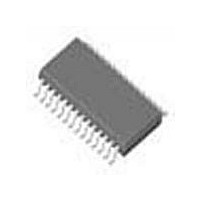LM4817MH National Semiconductor, LM4817MH Datasheet - Page 14

LM4817MH
Manufacturer Part Number
LM4817MH
Description
Manufacturer
National Semiconductor
Datasheet
1.LM4817MH.pdf
(21 pages)
Specifications of LM4817MH
Operational Class
Class-AB
Audio Amplifier Output Configuration
2-Channel Stereo
Output Power (typ)
1.1x2@8OhmW
Audio Amplifier Function
Speaker
Total Harmonic Distortion
0.13@8Ohm@1W%
Single Supply Voltage (typ)
5V
Dual Supply Voltage (typ)
Not RequiredV
Power Supply Requirement
Single
Rail/rail I/o Type
No
Power Supply Rejection Ratio
67dB
Single Supply Voltage (min)
3V
Single Supply Voltage (max)
5.5V
Dual Supply Voltage (min)
Not RequiredV
Dual Supply Voltage (max)
Not RequiredV
Operating Temp Range
-40C to 85C
Operating Temperature Classification
Industrial
Mounting
Surface Mount
Pin Count
28
Package Type
TSSOP EP
Lead Free Status / Rohs Status
Not Compliant
Available stocks
Company
Part Number
Manufacturer
Quantity
Price
Company:
Part Number:
LM4817MH
Manufacturer:
SKYWORKS
Quantity:
6 564
Part Number:
LM4817MH
Manufacturer:
NS/国半
Quantity:
20 000
Company:
Part Number:
LM4817MHX/NOPB
Manufacturer:
NS/TI
Quantity:
400
www.national.com
Application Information
SELECTING PROPER EXTERNAL COMPONENTS
Optimizing the LM4817’s performance requires properly se-
lecting external components. Though the LM4817 operates
well when using external components with wide tolerances,
best performance is achieved by optimizing component val-
ues.
The LM4817 is unity-gain stable, giving a designer maximum
design flexibility. The gain should be set to no more than a
given application requires. This allows the amplifier to
achieve minimum THD+N and maximum signal-to-noise ra-
tio. These parameters are compromised as the closed-loop
gain increases. However, low gain demands input signals
with greater voltage swings to achieve maximum output
power. Fortunately, many signal sources such as audio CO-
DECs have outputs of 1V
Audio Power Amplifier Design section for more informa-
tion on selecting the proper gain.
Input Capacitor Value Selection
Amplifying the lowest audio frequencies requires high value
input coupling capacitor (C
tor can be expensive and may compromise space efficiency
in portable designs. In many cases, however, the speakers
used in portable systems, whether internal or external, have
little ability to reproduce signals below 150Hz. Applications
using speakers with this limited frequency response reap
little improvement by using large input capacitor.
Besides effecting system cost and size, C
the LM4817’s click and pop performance. When the supply
voltage is first applied, a transient (pop) is created as the
charge on the input capacitor changes from zero to a quies-
cent state. The magnitude of the pop is directly proportional
to the input capacitor’s size. Higher value capacitors need
more time to reach a quiescent DC voltage (usually V
when charged with a fixed current. The amplifier’s output
charges the input capacitor through the feedback resistor,
R
capacitor value that is no higher than necessary to meet the
desired -3dB frequency.
A shown in Figure 1, the input resistor (R
capacitor, C
that is found using Equation (7).
As an example when using a speaker with a low frequency
limit of 150Hz, C
C
ciency, full range speaker whose response extends below
30Hz.
Bypass Capacitor Value Selection
Besides minimizing the input capacitor size, careful consid-
eration should be paid to value of C
nected to the BYPASS pin. Since C
f
I
. Thus, pops can be minimized by selecting an input
shown in Figure 1 allows the LM4817 to drive high effi-
I
produce a −3dB high pass filter cutoff frequency
I
, using Equation (4), is 0.063µF. The 1.0µF
RMS
i
in Figure 1). A high value capaci-
(2.83V
P-P
B
B
determines how fast
). Please refer to the
, the capacitor con-
(Continued)
i
has an affect on
I
) and the input
DD
(7)
/2)
14
the LM4817 settles to quiescent operation, its value is critical
when minimizing turn−on pops. The slower the LM4817’s
outputs ramp to their quiescent DC voltage (nominally 1/2
V
1.0µF along with a small value of C
0.39µF), produces a click-less and pop-less shutdown func-
tion. As discussed above, choosing C
sary for the desired bandwidth helps minimize clicks and
pops.
OPTIMIZING CLICK AND POP REDUCTION
PERFORMANCE
The LM4817 contains circuitry to minimize turn-on and shut-
down transients or "clicks and pop". For this discussion,
turn-on refers to either applying the power supply voltage or
when the shutdown mode is deactivated. While the power
supply is ramping to its final value, the LM4817’s internal
amplifiers are configured as unity gain buffers. An internal
current source changes the voltage of the BYPASS pin in a
controlled, linear manner. Ideally, the input and outputs track
the voltage applied to the BYPASS pin. The gain of the
internal amplifiers remains unity until the voltage on the
bypass pin reaches 1/2 V
BYPASS pin is stable, the device becomes fully operational.
Although the bypass pin current cannot be modified, chang-
ing the size of C
magnitude of "clicks and pops". Increasing the value of C
reduces the magnitude of turn-on pops. However, this pre-
sents a tradeoff: as the size of C
increases. There is a linear relationship between the size of
C
for various values of C
In order eliminate "clicks and pops", all capacitors must be
discharged before turn-on. Rapidly switching V
allow the capacitors to fully discharge, which may cause
"clicks and pops".
NO LOAD STABILITY
The LM4817 may exhibit low level oscillation when the load
resistance is greater than 10kΩ. This oscillation only occurs
as the output signal swings near the supply voltages. Pre-
vent this oscillation by connecting a 5kΩ between the output
pins and ground.
DD
B
and the turn-on time. Here are some typical turn-on times
), the smaller the turn−on pop. Choosing C
B
alters the device’s turn-on time and the
C
0.01µF
0.22µF
0.47µF
B
0.1µF
1.0µF
B
:
DD
. As soon as the voltage on the
B
increases, the turn-on time
T
200 ms
440 ms
940 ms
i
ON
20 ms
(in the range of 0.1µF to
2 Sec
i
no larger than neces-
DD
B
equal to
may not
B











